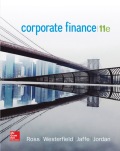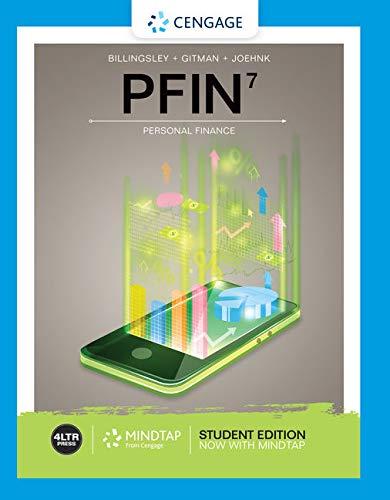
EBK CORPORATE FINANCE
11th Edition
ISBN: 8220102798878
Author: Ross
Publisher: YUZU
expand_more
expand_more
format_list_bulleted
Question
Chapter 10, Problem 4MC
Summary Introduction
To Determine: The Reasons on Investing in the Fund and its Effects.
Introduction: Annualized Percentage Rate (APR) is defined as the total interest rate that is paid in a year which replicates all the costs of a loan for the duration of one year. Effective Annual Rate (EAR) is defined as the interest rate an investor earns in a current year after book-keeping for the results of compounding.
Expert Solution & Answer
Want to see the full answer?
Check out a sample textbook solution
Students have asked these similar questions
no ai
What is compound interest, and why is it important in personal finance?
No ai
The time value of money concept suggests:A. Money loses value over timeB. Inflation doesn’t matterC. Future money is more valuableD. Money today is worth more than tomorrow
A food processing company is considering replacing essential
machinery. Cost and relevant cash flow details are provided in
the table at the right. The company requires an 11% return on
its capital.
a) What is the present value of the yearly cash flows? Use a
Time Value of Money function for full credit. (round to nearest
dollar)
b) What is the net present value of the project? (round to
nearest dollar)
c) What is the internal rate of return of the project? Use a
Time Value of Money function for full credit. (round to two
decimal places)
Chapter 10 Solutions
EBK CORPORATE FINANCE
Ch. 10 - Investment Selection Given that RadNet was up by...Ch. 10 - Investment Selection Given that Transocean was...Ch. 10 - Risk and Return We have seen that over long...Ch. 10 - Prob. 4CQCh. 10 - Effects of inflation Look at Table 10.1 and Figure...Ch. 10 - Risk Premiums Is it possible for the risk premium...Ch. 10 - Prob. 7CQCh. 10 - Returns Two years ago, the Lake Minerals and Small...Ch. 10 - Prob. 9CQCh. 10 - Historical Returns The historical asset class...
Ch. 10 - Calculating Returns Suppose a stock had an initial...Ch. 10 - Calculating Yields In Problem 1, what was the...Ch. 10 - Calculating Returns Rework Problems 1 and 2...Ch. 10 - Prob. 4QPCh. 10 - Prob. 5QPCh. 10 - Bond Returns What is the historical real return on...Ch. 10 - Calculating Returns and Variability Using the...Ch. 10 - Risk Premiums Refer to Table 10.1 in the text and...Ch. 10 - Prob. 9QPCh. 10 - Prob. 10QPCh. 10 - Calculating Real Rates Given the information in...Ch. 10 - Holding Period Return A stock has had returns of...Ch. 10 - Prob. 13QPCh. 10 - Prob. 14QPCh. 10 - Calculating Returns You bought a stock three...Ch. 10 - Calculating Real Returns Refer to Table 10.1. What...Ch. 10 - Return Distributions Refer back to Table 10.2....Ch. 10 - Prob. 18QPCh. 10 - Calculating Returns and Variability You find a...Ch. 10 - Arithmetic and Geometric Returns A stock has had...Ch. 10 - Arithmetic and Geometric Returns A stock has had...Ch. 10 - Calculating Returns Refer to Table 10.1 in the...Ch. 10 - Prob. 23QPCh. 10 - Using Return Distributions Suppose the returns on...Ch. 10 - Using Return Distributions Assuming that the...Ch. 10 - Prob. 26QPCh. 10 - Using Probability Distributions Suppose the...Ch. 10 - Prob. 28QPCh. 10 - Prob. 1MCCh. 10 - Prob. 2MCCh. 10 - Assume you decide you should invest at least part...Ch. 10 - Prob. 4MCCh. 10 - A measure of risk-adjusted performance that is...Ch. 10 - What portfolio allocation would you choose? Why?...
Knowledge Booster
Similar questions
- what is the firms' weighted average cost of capital? please show me weight calculation for each capital source.arrow_forwardA small manufacturer is considering an equipment replacement project. The new equipment would have an installed cost of $125,000 and would replace existing equipment that was purchased 3 years ago at an installed cost of $80,000. If the company moves forward with the replacement, it could sell the old equipment for $25,000. Purchasing the new equipment would result in the company's current assets increasing by $12,000 and current liabilities increasing by $9,000. The company uses the 5-year MACRS table for depreciation, and is taxed at 21%. a) What is the accumulated depreciation of the old equipment? b) What is the current book value of the old equipment? c) What is the amount of depreciation recapture/recovery? d) What is the tax on the sale of the old equipment? e) What are the after-tax proceeds from the sale of the old equipment? f) What is the change in Net Working Capital? g) What is the initial investment for the project?arrow_forwardLast year Lewis Bank paid an annual dividend of $7 per share. The bank expects the growth of its dividends to be stable at 2% per year going forward. a) If investors require an 8% return, what is the current value of Lewis Bank's stock? (round to nearest cent) b) If the stock currently trades at $124.55 per share, what is the dividend growth rate investors expect? (round to nearest percent)arrow_forward
- A food processing company is considering replacing essential machinery. Cost and relevant cash flow details are provided in the table at the right. The company requires an 11% return on its capital. a) What is the present value of the yearly cash flows? Use a Time Value of Money function for full credit. (round to nearest dollar) b) What is the net present value of the project? (round to nearest dollar) c) What is the internal rate of return of the project? Use a Time Value of Money function for full credit. (round to two decimal places)arrow_forwardBarnsa is planning to raise a total of $5,000,000 with a bond issue. Each of the bonds has a face (par) value of $1,000 and coupon rate of 4%. The company's applicable tax rate is 21%. a) What is the annual coupon payment, per bond, that investors expect to receive? b) What is the total after-tax annual interest expense to Barnsa?arrow_forwardA team of analysts is using a two-stage variable growth model to estimate the value of GNC's common stock. The most recent annual dividend paid by GNC was $4 per share. The analysts expect dividends to increase 7% per year for the next 3 years and then drop to 3% starting in year 4 and remain at that rate for the foreseable future. The required rate of return used for the analysis is 8%. a) What are the expected dividends for the next 4 years? b) What is the value of the stock attributable to the first 3 years of dividends? (use NPV function) c) What is the value of the stock at the end of year 3? (use constant-growth model) Use a cell reference in the numerator to get an unrounded, more precise, answer figure. d) What is the value of the stock attributable to years 4 and beyond? (use pv function, where answer to part C is the fv) e) What is the total value of GNC stock?arrow_forward
- An investor is buying a bond that pays semi-annual interest. The par value is $900 and the coupon rate is 6%. The investor plans to hold the bond to its maturity, which is 5 years from now. If her typical required rate of return is 7%, what is the most the investor should pay for the bond? Use a Time Value of Money function for full credit. (round to nearest cent)arrow_forwardIRR: Mutually exclusive projects Nile Inc. wants to choose the better of two mutually exclusive projects that expand warehouse capacity. The projects' cash flows are shown in the following table: The cost of capital is 18%. a. Calculate the IRR for each of the projects. Assess the acceptability of each project on the basis of the IRRs. b. Which project is preferred? a. The internal rate of return (IRR) of project X is %. (Round to two decimal places.) Is project X acceptable on the basis of IRR? (Select the best answer below.) Yes No The internal rate of return (IRR) of project Y is %. (Round to two decimal places.) Is project Y acceptable on the basis of IRR? (Select the best answer below.) ○ Yes Ο No b. Which project is preferred? (Select the best answer below.) A. Project X B. Project Y C. Neitherarrow_forwardA preferred stock has a par value of $105 and pays an annual dividend of 3% of par. If similar investments have an annual rate of return of 5%, what is the current value of this preferred stock. (round to nearest cent)arrow_forward
- Common stock value-Variable growth Lawrence Industries' most recent annual dividend was $1.82 per share (Do = $1.82), and the firm's required return is 15%. Find the market value of Lawrence's shares when dividends are expected to grow at 30% annually for 3 years, followed by a 6% constant annual growth rate in years 4 to infinity. The market value of Lawrence's shares is $ (Round to the nearest cent.)arrow_forwardDepreciation A firm is evaluating the acquisition of an asset that costs $68,400 and requires $3,990 in installation costs. If the firm depreciates the asset under MACRS, using a five-year recovery period (see table |), determine the depreciation charge for each year. The annual depreciation expense for year 1 will be $ The annual depreciation expense for year 2 will be $ The annual depreciation expense for year 3 will be $ The annual depreciation expense for year 4 will be $ The annual depreciation expense for year 5 will be $ The annual depreciation expense for year 6 will be $ (Round to the nearest dollar.) (Round to the nearest dollar.) (Round to the nearest dollar.) (Round to the nearest dollar.) (Round to the nearest dollar.) (Round to the nearest dollar.)arrow_forwardIntegrative Risk and valuation Giant Enterprises' stock has a required return of 15.9%. The company, which plans to pay a dividend of $2.22 per share in the coming year, anticipates that its future dividends will increase at an annual rate consistent with that experienced over 2016-2022 period, when the following dividends were paid: a. If the risk-free rate is 6%, what is the risk premium on Giant's stock? b. Using the constant-growth model, estimate the value of Giant's stock. (Hint: Round the computed dividend growth rate to the nearest whole percent.) c. Explain what effect, if any, a decrease in the risk premium would have on the value of Giant's stock. a. If the risk-free rate is 6%, the risk premium on Giant's stock is %. (Round to one decimal place.) (Round to the nearest cent.) b. Using the constant-growth model, the value of Giant's stock is $ c. Explain what effect, if any, a decrease in the risk premium would have on the value of Giant's stock. (Select from the drop-down…arrow_forward
arrow_back_ios
SEE MORE QUESTIONS
arrow_forward_ios
Recommended textbooks for you
 Pfin (with Mindtap, 1 Term Printed Access Card) (...FinanceISBN:9780357033609Author:Randall Billingsley, Lawrence J. Gitman, Michael D. JoehnkPublisher:Cengage Learning
Pfin (with Mindtap, 1 Term Printed Access Card) (...FinanceISBN:9780357033609Author:Randall Billingsley, Lawrence J. Gitman, Michael D. JoehnkPublisher:Cengage Learning Managerial Accounting: The Cornerstone of Busines...AccountingISBN:9781337115773Author:Maryanne M. Mowen, Don R. Hansen, Dan L. HeitgerPublisher:Cengage Learning
Managerial Accounting: The Cornerstone of Busines...AccountingISBN:9781337115773Author:Maryanne M. Mowen, Don R. Hansen, Dan L. HeitgerPublisher:Cengage Learning

Pfin (with Mindtap, 1 Term Printed Access Card) (...
Finance
ISBN:9780357033609
Author:Randall Billingsley, Lawrence J. Gitman, Michael D. Joehnk
Publisher:Cengage Learning


Managerial Accounting: The Cornerstone of Busines...
Accounting
ISBN:9781337115773
Author:Maryanne M. Mowen, Don R. Hansen, Dan L. Heitger
Publisher:Cengage Learning